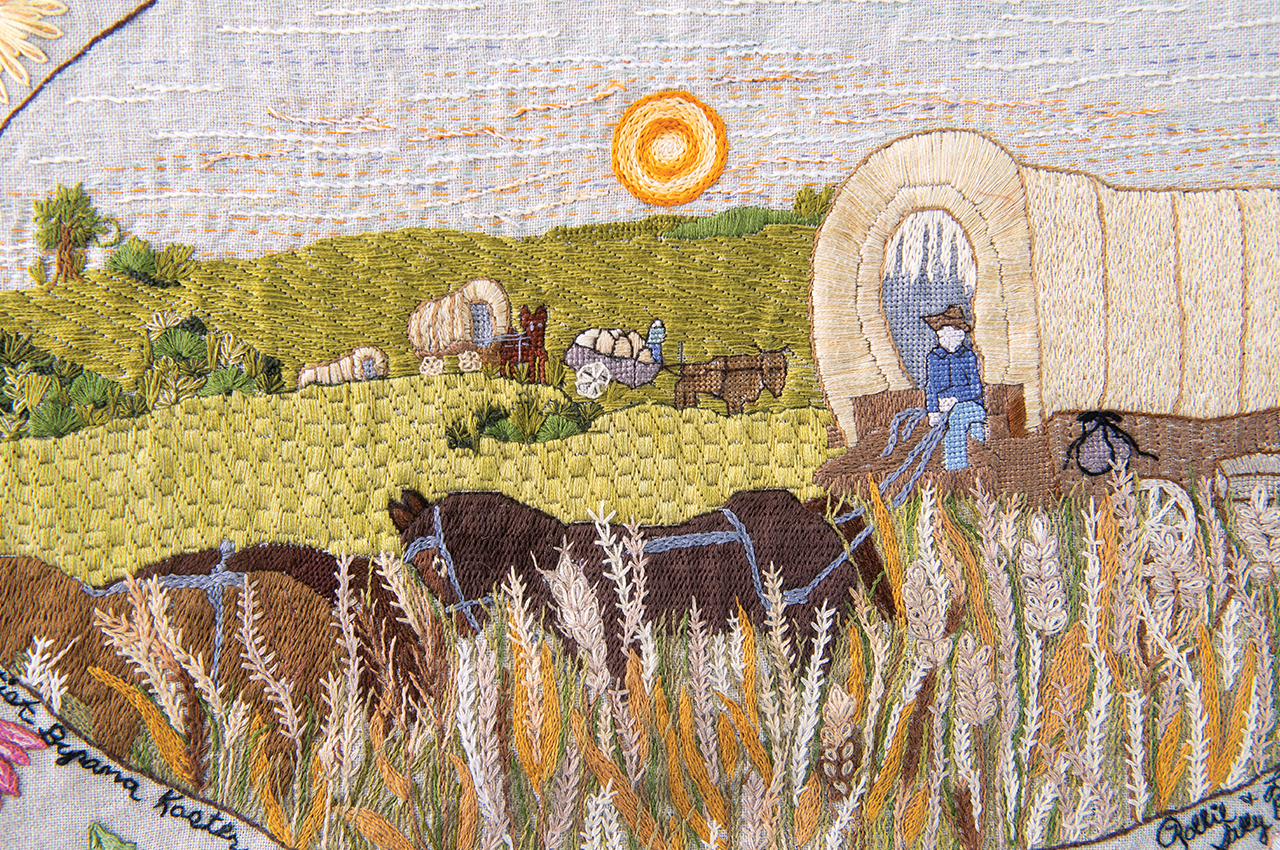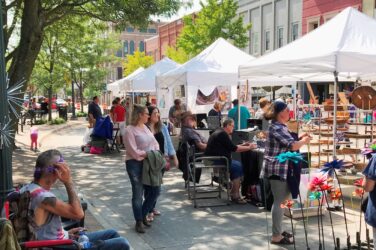Writer: Michael Morain
Photographer: Duane Tinkey
On a sunny summer day in Centerville, almost three dozen folks lined up on the courthouse lawn to hold up a tapestry that tells the history of Appanoose County.
It measures about 100 feet long and took about 10 years to make — even longer if you count the book that inspired it. In all, some 60 local artists, quilters, needlepointers and others pitched in to help, but none had seen it in all its glory until they lined up for a photo.
They were collectively proud and individually humble. Whenever anyone received a compliment, he or she — usually she — swatted it away. “Oh, that’s nothing,” she’d say. “You should see what so-and-so did. She’s the one with the real talent.”
“If you want somebody to blame for this whole thing, it’s Debbie [Robinson],” Jan Vander Linden said, tossing Robinson a look of friendly accusation. “She just gets these ideas and thinks, ‘Well, let’s see who can do it.’”
Robinson didn’t deny it. She taught family and consumer sciences for more than 30 years at the local high school and has busied herself with community projects since her retirement. But even she didn’t predict how the tapestry would just keep growing. Stitch by stitch. Panel by panel.
There are 13 panels in all, each about 7 feel long and 2 feet tall. Fifty-two historical scenes span two centuries, from Meskwaki chief Appanoose to opera singer Simon Estes, rolling out like a comic strip between patchwork stripes along the top and bottom borders. Embroidered local wildflowers fill the gaps, sprouting among flags that represent more than 40 countries from which the county’s residents emigrated. Tatted lace medallions pop up here and there, along with numbered metal discs made from ID tags like the ones coal miners used to wear into the mines that once perforated southeast Iowa.
Robinson gently ran her hand over a stack of panels on a picnic table outside the courthouse. “Sometimes I dreaded working on these. I thought they’d never get done,” she confessed. “But whenever we finally finished one, we couldn’t wait to do more. They were just so beautiful.”
MOST OF THE TAPESTRY’S HISTORICAL SCENES are based on “Centerville: A Mid-American Saga,” a hefty 750-page book that local historian Enfys McMurry published through the History Press in 2012.
The author grew up in Wales, moved to Iowa with her Iowan husband about 50 years ago and taught humanities courses for many years at the local community college. “I really got interested in the Centerville story when I was teaching those kids at Indian Hills, the best kids in the world,” she said. “I would hear bits and pieces while I was teaching, almost like a jigsaw puzzle. Then when I retired, I had time to tackle it.”
The tackling started at the local library and the courthouse, where McMurry often sat for hours cross-legged on the floor, poring over bound copies of the Daily Iowegian and its predecessors, dating to the 1860s and ’70s. She focused her initial research on the Underground Railroad, considering the county’s proximity to the Missouri state line, but quickly expanded her scope as she learned more.
“Centerville is a microcosm of the American story,” she said. “The Civil War, the KKK, the murders, the booze, the First World War and immigrants from 40 different countries — four zero! — some of whom had to go and fight in the very countries where they were born.
“I was just riveted, fascinated with this town,” she said.
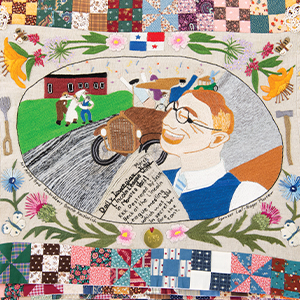
The Appanoose Remembrance Tapestry chronicles turning points in local history, including the rise and electoral defeat of the Ku Klux Klan in the 1920s.
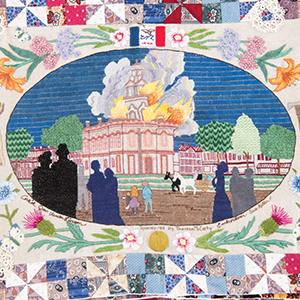
Independence Day fireworks that ignited the county courthouse in 1881.
NOT LONG AFTER MCMURRY PUBLISHED HER BOOK, she took a trip back to Wales and had a chance to see a tapestry in Fishguard, a village near the western tip of the Welsh coast. The 100-foot “Last Invasion Tapestry” was commissioned in 1997 to commemorate the bicentennial of the last invasion of mainland Britain, when Welsh locals, including many women, fended off French soldiers who landed a few miles west of town.
The artwork was inspired by a much older project, the famous 230-foot Bayeux Tapestry in France, which tells the tale of French duke William the Conqueror’s successful invasion of Britain in 1066. History is written, or embroidered, by the victors.
McMurry and her cousin watched a presentation in Fishguard and then, as she tells it, “We leaped to our feet and said, ‘Centerville!’” She grabbed some pamphlets, a diagram and a DVD and, soon enough, was delivering a presentation of her own back in Centerville.
“I invited this group of enormously talented women who spent their winters making quilts for their grandchildren, and I said, ‘Look, you’re all brilliant at what you do, but why don’t you do something as a community?’” said McMurry, who is not crafty herself. “One woman stood up to leave and said, ‘You’re raving mad.’”
MCMURRY’S IDEA DIDN’T REALLY CATCH ON until she was invited to pitch it to a quilt guild in Indianola, whose members expressed an interest in taking it on — until word got back to Debbie Robinson.
“Well, I’m not having it,” she said. “If it’s about Centerville, it’s going to be done in Centerville.”
As in Fishguard, all it took was the threat of an invasion. A committee mobilized. Supplies were mustered. Funds were raised through social media, the newspaper, exhibits at the county fair and the annual Pancake Day, and “any other idea that is legal and effective,” according to minutes from a 2016 meeting of the newly formed Appanoose Remembrance Tapestry Society (ARTS). Local groups sponsored panels for $200 apiece.
Robinson, ever the teacher, taught “Embroidery 101” at the local library to enlist more participants. One by one, folks stepped up to help. Joyce Stufflebeem helped ordered a bolt of Irish linen. Nancy Kelly and Sue Sacco donated some skeins of embroidery floss.
Various local artists — including Nancy Bennett, Judy Buban, Marybeth Heikes, Byranna Kaster, Jan Vanderlinden and John Wiltamuth — drew or painted historical scenes from old postcards or photos, which served as outlines for the embroidery. Roger Kinnamon pitched in, too, after a year of prodding. “If I’d known it was going to be so amazing,” he said, “I would have done more.”
Elaine Spencer tatted 62 lace medallions, dusting off skills she’d learned from her grandmother. Cindy Burnside, Sandy Nab and Rita West assembled the tidy piecework borders from a gazillion tiny squares.
THE LIST GOES ON, with too many loose ends to tie up in a single article. But the contributors know who they are, and whenever they pass the PACT building — Promoting Appanoose and Centerville Together — on the southwest corner of the square, they can peek in the window and see their handiwork, hanging on a giant wall in the conference room. The panels are displayed in frames that can be rearranged to mark various anniversaries as time keeps unspooling into the future.
The first Mormon trek across Iowa in 1846. The county baseball team in the 1880s. The courthouse fire of 1881. The coal-mining towns that flourished and disappeared. The Spanish Flu in 1918. The first women who served on a local jury in 1920. The girls’ state basketball champions in 1932. The polio vaccine in 1955. The sabotaged plane that crashed in 1962, killing all 45 passengers and crew. The completion of the Rathbun Dam in 1969.
The completion of the tapestry in 2024.
Early on, when McMurry was still trying to cajole folks into taking on the project, she promised that if it actually happened, she’d gather everyone for a toast at the Ritz, an old movie theater on the town square. One woman told her, “Oh, Enfys, it’s always been my dream to drink Champagne at the Ritz.”
Now, that dream comes true.
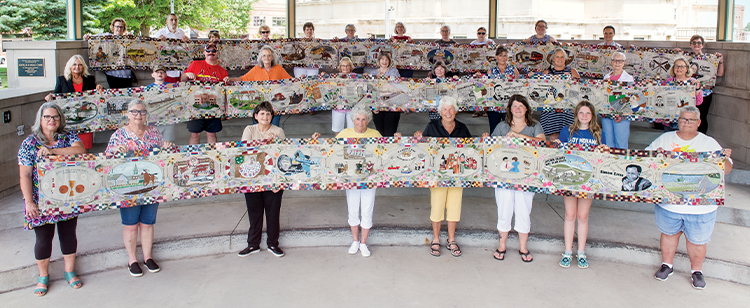
Dozens of volunteers who helped make the Appanoose Remembrance Tapestry gathered on July 8, 2024, for a photo on the courthouse square.
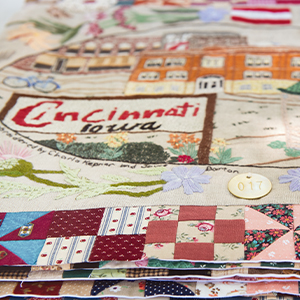
Tapestry panel No. 17 features Cincinnati, one of many coal-mining towns that popped up in Appanoose County in the 1800s. The metal disc is like the ID tags miners used to wear during their shifts.

Panel No. 7 recounts a night in 1845 when campers along the Mormon Trail helped stamp out a prairie fire and received some thank-you pumpkins.
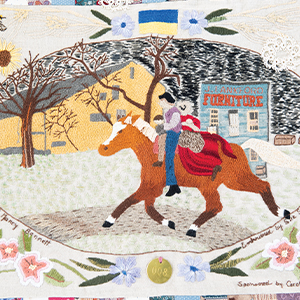
Panel No. 8 tells the tale of John Lankford, a carpenter who helped freedom seekers on the Underground Railroad in the 1850s.


